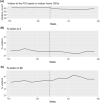Exposure to infection when accessing groceries reveals racial and socioeconomic inequities in navigating the pandemic
- PMID: 36774420
- PMCID: PMC9922100
- DOI: 10.1038/s41598-023-28194-y
Exposure to infection when accessing groceries reveals racial and socioeconomic inequities in navigating the pandemic
Abstract
Disasters often create inequitable consequences along racial and socioeconomic lines, but a pandemic is distinctive in that communities must navigate the ongoing hazards of infection exposure. We examine this for accessing essential needs, specifically groceries. We propose three strategies for mitigating risk when accessing groceries: visit grocery stores less often; prioritize generalist grocery stores; seek out stores whose clientele have lower infection rates. The study uses a unique combination of data to examine racial and socioeconomic inequities in the ability to employ these strategies in the census block groups of greater Boston, MA in April 2020, including cellphone-generated GPS records to observe store visits, a resident survey, localized infection rates, and demographic and infrastructural characteristics. We also present an original quantification of the amount of infection risk exposure when visiting grocery stores using visits, volume of visitors at each store, and infection rates of those visitors' communities. Each of the three strategies for mitigating exposure were employed in Boston, though differentially by community. Communities with more Black and Latinx residents and lower income made relatively more grocery store visits. This was best explained by differential use of grocery delivery services. Exposure and exposure per visit were higher in communities with more Black and Latinx residents and higher infection rates even when accounting for strategies that diminish exposure. The findings highlight two forms of inequities: using wealth to transfer risk to others through grocery deliveries; and behavioral segregation by race that makes it difficult for marginalized communities to avoid hazards.
© 2023. The Author(s).
Conflict of interest statement
The authors declare no competing interests.
Figures



Similar articles
-
Rapid, point-of-care antigen tests for diagnosis of SARS-CoV-2 infection.Cochrane Database Syst Rev. 2022 Jul 22;7(7):CD013705. doi: 10.1002/14651858.CD013705.pub3. Cochrane Database Syst Rev. 2022. PMID: 35866452 Free PMC article.
-
Behavioral interventions to reduce risk for sexual transmission of HIV among men who have sex with men.Cochrane Database Syst Rev. 2008 Jul 16;(3):CD001230. doi: 10.1002/14651858.CD001230.pub2. Cochrane Database Syst Rev. 2008. PMID: 18646068
-
Sexual Harassment and Prevention Training.2024 Mar 29. In: StatPearls [Internet]. Treasure Island (FL): StatPearls Publishing; 2025 Jan–. 2024 Mar 29. In: StatPearls [Internet]. Treasure Island (FL): StatPearls Publishing; 2025 Jan–. PMID: 36508513 Free Books & Documents.
-
Comparison of Two Modern Survival Prediction Tools, SORG-MLA and METSSS, in Patients With Symptomatic Long-bone Metastases Who Underwent Local Treatment With Surgery Followed by Radiotherapy and With Radiotherapy Alone.Clin Orthop Relat Res. 2024 Dec 1;482(12):2193-2208. doi: 10.1097/CORR.0000000000003185. Epub 2024 Jul 23. Clin Orthop Relat Res. 2024. PMID: 39051924
-
How lived experiences of illness trajectories, burdens of treatment, and social inequalities shape service user and caregiver participation in health and social care: a theory-informed qualitative evidence synthesis.Health Soc Care Deliv Res. 2025 Jun;13(24):1-120. doi: 10.3310/HGTQ8159. Health Soc Care Deliv Res. 2025. PMID: 40548558
References
-
- Kinder M, Ross M. Reopening America: Low-Wage Workers have Suffered Badly from COVID-19 so Policymakers Should Focus on Equity. Brookings Institute; 2020.
Publication types
MeSH terms
LinkOut - more resources
Full Text Sources
Miscellaneous

